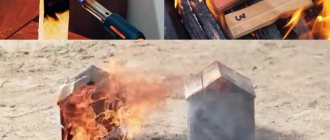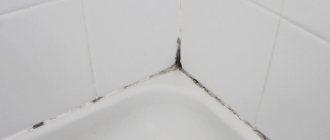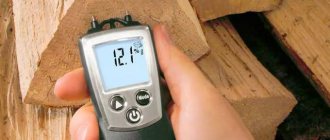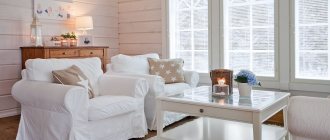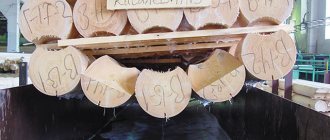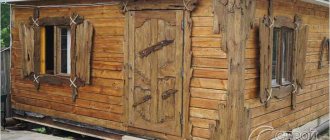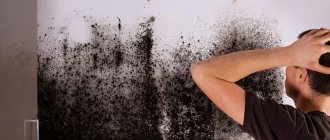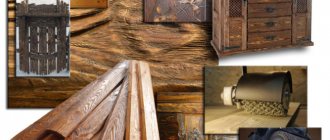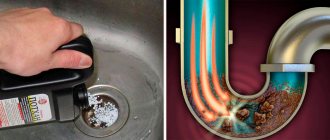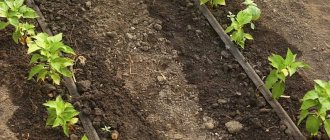In our country, wood is perhaps the most popular building material. Wood is used to build buildings for various purposes, it is used for interior decoration, furniture, decor for garden plots and much more are made from it. Such popularity of wood is explained by such qualities as strength, beauty, good sound insulation, and environmental friendliness.
Wood as a building material has many fans. It is used by both large manufacturers and ordinary people.
Unfortunately, such qualities of wood as beauty and nobility please the eye only up to a certain point, because after some time the wood can become covered with mold or mildew. In this regard, when using wood in different areas, it is necessary to take into account its peculiarity - it is afraid of moisture, which quickly leads to rotting and the appearance of various pests.
Recommendations for use
Water-based antiseptic impregnations are used to treat wood that will not come into contact with water or moisture during operation. This is a material that can be used to impregnate wooden cladding of interior spaces. This impregnation takes several hours to dry. The water contained in the antiseptic can negatively affect the quality of the wood, causing warping and cracking.
Oil-based impregnations are used if wooden materials will come into contact with water. For example, the timber from which the house is built, a fence with posts, etc. They change the color of the wood, they have a strong and pungent odor that lasts a long time.
Compositions based on organic solvents, after drying, form a thin hydrophobic film on the surface of the wood that does not allow water to pass through. They can be used both outdoors and indoors.
Using traditional methods
Protecting wood from moisture and rot can be done using folk remedies. They have many advantages over synthetic compounds. This type of treatment is cheaper. It is environmentally safe and hypoallergenic. In addition, it is available to any home craftsman.
Wood can be treated with propolis and sunflower oil. For this purpose, materials are taken in a ratio of 1:3. They should be mixed well and applied to a surface that has been previously cleaned of dust using a soft sponge. This method of protecting wood from moisture and rotting is good because it is as strong as possible and helps prevent the formation of microorganisms. However, it has one big drawback, which is that the material has an increased ability to ignite. Therefore, you should consider whether it is advisable to use such impregnation in each individual case.
Quite often, consumers use iron sulfate to treat wood. To do this, you should purchase a ready-made solution that mixes well. A soft sponge or rag is dipped in it, which is used to impregnate clean wood.
Protecting wood from moisture and rotting with iron sulfate is ideal for round logs, since the product is not too expensive. Also extremely effective. With strong impregnation, the material will be ready to serve for quite a long time, without requiring additional protection work. The only downside of this product is the long drying time.
Wood impregnated with iron sulfate should be left in the open air, and exposure of the material to sunlight should be avoided. You can use a special canopy for this. The material is left to dry from a week to a month.
You need to know the enemy by sight - a short description of pests
In fact, there are hundreds and even thousands of different beetles and other insects in the world that can harm wood to varying degrees.
It’s just that the scale of damage varies greatly depending on the type, and the nature of the damage may differ:
- some insects limit themselves to making their passages only under the bark. Of course, this is considered a defect, but such a trunk can still be used in construction if there is no other damage;
The result of the bark beetle's work
- it is much worse when the beetles or their larvae go deep into the woody massif and literally pierce it with hundreds of thin passages. Naturally, if such wood can be used, it can only be used as fuel.
This wood is only suitable as fuel.
Note! The situation can be aggravated by the fact that fungi parasitizing trees gladly take advantage of such “services” from insects and spread along the passages. As a result, even durable wood turns into weightless dust, losing its value even as fuel - much less heat will be released during combustion.
As for what types of tree pests there are, it is simply impossible to provide a complete list and brief description of all pests. Therefore, we will limit ourselves to only some well-known and most “effective” insects characteristic of our latitudes.
The following types of insects can be distinguished:
- longhorned beetle. The female longhorned beetle can be considered one of the most insidious enemies of wood - she can lay 200-300 eggs in a crack, and the larvae will then quietly feast on the wood for 2-3 years. At the same time, nothing can be noticed from the outside; often the defect can only be noticed if you knock on the wood;
Longhorned beetle and wood damage
Note! The danger comes only from beetle larvae; adult beetles are absolutely safe for the tree.
- The grinder beetle should also be listed as a pest of wooden houses. The only difference from the longhorned beetle is that the number of larvae is smaller (maximum - 40 pieces), moreover, the passages are visible on the surface, so the damage can be diagnosed quite easily;
In the photo - a beetle grinder and possible damage to wood
- The common engraver does not cause as much damage as the listed beetles - it is limited to penetrating under the bark to a shallow depth. If you remove the bark from the trunk, you can see a small depression - the uterine chamber and the uterine ducts extending from it. The surface of the tree under the bark is very densely covered with larval passages;
- When weevils are mentioned as a pest, usually no one specifies the specific type of insect. In principle, damage from different types of weevils is not very different - the female simply gnaws out a chamber in the bark for the eggs, and the larvae then gradually move into the phloem.
Damage from weevils
Note! Some types of weevils, for example, pine gum, also cause blueing of wood. This is a natural reaction to spores that fall under the bark along with insects.
Causes and signs of pest appearance
The main reason for its appearance is the use of low-quality wood that has not been treated with impregnations against borer beetles. Over time, the protective layer loses its properties. During the mating period, beetles fly to other wooden structures and make new clutches. It is necessary to periodically inspect surfaces and protect wood from woodworms. Impregnate periodically with a new layer of insecticides.
Signs of the appearance of grinder beetles:
- small holes on the surface of wooden structures, furniture; the appearance of wooden pollen, similar in color to mustard powder; rustling, tapping inside the solid wood in the evening, at night; a characteristic odor from insect secretions, insect pheromones; if you remove the outer layer, you can see grooves , larval passages.
You need to start exterminating beetles immediately, as soon as the first signs appear.
Tap the wood, the sound is different. In a healthy tree it is dull, in a damaged tree it is louder, due to the presence of voids. Pollen will begin to fall out of small tree holes.
Signs of infection
It is important to identify the problem immediately, otherwise lumber or wooden furniture can become a real biological weapon.
Signs:
- Visible remains of burrows on the wane indicate the presence of a “surprise” in the wood in the form of a bark beetle.
- If the board has no visible signs of damage, but is surprisingly light, termites or shashel can live in it.
- Wood meal can indicate the presence of any insect from the above trinity.
It will not be possible to eliminate defects in damaged wood. Insects live “in grand style”, creating many passages. Therefore, if you see that the lumber you are purchasing has a “bonus” in the form of a pest, it is better not to buy it at all, even on the cheap. If you have already purchased boards, timber, lining and there is no way to return the lumber, it is better to burn it. This way you will prevent the spread of pests throughout the area.
You can even hear the larvae: as they destroy wood, they make a grinding noise.
How to protect and care for wood
Wood protected by impregnation is additionally coated with varnish, varnish, paint or oil. The choice of product depends on what effect we want to get.
In country (rustic) style gardens, wood looks good in its natural form - with a transparent coating that does not change the color of the wood - as well as painted in bright colors. The second option is also combined with modern style. Furniture or wooden structures in pastel colors will look great in English-style gardens.
Varnishing wood
Externally, varnishes specifically designed for this purpose should be used. They form an elastic shell. Parquet varnish used on the outside will quickly crack (moisture will penetrate into the cracks, and this is only a step for the development of fungus).
If possible, we carry out impregnation under a canopy (or wait for good weather) - the wood should not be exposed to moisture, either during or after the impregnation procedure. The drying time of the preparations is quite different.
Lakobeyts – lakomorilka
This is a coloring varnish - creates a transparent shell that emphasizes the natural pattern of the tree's rings, most often brown, green or blue. It is often used for painting furniture and fences - because it protects and decorates at the same time.
Enamel
Forms a film through which the wood loses a little of its natural, noble appearance. Often used to update the appearance of furniture or fences previously painted this way. Rarely, however, is it used to finish the surface of a terrace - the enamel coating is not very resistant to damage (it is absorbed rather superficially and creates a layer that prevents the wood from breathing).
Oil
Penetrates deeply, protecting the wood from moisture absorption. Treated in this way, it will please the eye for many years. Terrace boards are most often coated with oil. The preparation is applied until the wood absorbs; excess must be removed.
If you have something to add, please be sure to leave your comment on the site>>>
Types of antiseptic compounds
The construction market offers a huge number of different antiseptic agents, which are divided according to the following criteria - based on their basis, scope of use, functional features and cost.
To choose the right wood preservative, let’s take a closer look at each type.
The basis
All antiseptics have a different base, which is determined by the active components included in their composition.
The following categories of antiseptics are distinguished:
- water soluble
- oil,
- organic,
- combined.
Water soluble
Water-soluble antiseptics are intended for the prevention of any type of wood. Such compositions are suitable for impregnating various surfaces that are not directly exposed to excess moisture or water. The composition of water-soluble impregnations includes sodium fluoride and silicofluoride, boric acid and borax. They have a short drying time after application to the surface.
Oily
Oil-based antiseptics are the most popular because they are designed to protect wood from the negative effects of moisture. Non-washable impregnations are made on the basis of oils - anthracene, shale, creosote, coal and semi-coke.
Despite their effectiveness and good protection results, oil compositions are highly toxic, flammable and have an unpleasant chemical odor.
In addition, such impregnations can color wooden surfaces, giving them richer shades.
Organic
Organic-based antiseptics are used to impregnate structures and decorative elements inside and outside buildings. When applied, they create a durable, indelible film with excellent adhesive and hydrophobic properties.
Natural impregnations are developed for pre-treatment of modern lumber - timber, logs or boards used for the construction of walls.
The compositions color the wood green and increase its porosity, promoting the formation of corrosion on metal elements that are connected to the wooden base.
Combined
To produce combined formulations, a mineral base (salt) and an organic solvent are used, so they are able to perform the functions of antiseptics and fire retardants.
Such antiseptics provide reliable protection for wood from parasitic insects, mold, rotting and burning. In addition, some preparations contain safe coloring components, which, in addition to coloring, provide wood surfaces with maximum resistance to ultraviolet radiation.
Scope of use
The choice of suitable protective impregnation is determined depending on the type of wood and its purpose. According to the scope of use, antiseptics are divided into 2 categories:
- for external processing,
- for internal processing.
For outdoor use
Here are presented antiseptic compositions that are suitable for external wood treatment. They have excellent resistance to atmospheric influences - ultraviolet radiation, high humidity and temperature changes.
Antiseptics for external use have a strong chemical odor, which disappears after the treated surface has completely dried. Such preparations are not suitable for treating wood indoors.
Substances are divided into 2 types:
- Deep penetration impregnations are designed to destroy mold, fungi and pests.
- Finishing compounds are provided to protect the impregnating layer from wind load. They do not penetrate deeply into wood fibers, but are able to create a durable film on the treated surface.
For interior work
This includes antiseptic solutions based on environmentally friendly components, which are used to treat wood surfaces indoors. They have no chemical odor and do not release toxic substances into the air.
Deep penetration wood antiseptics have a prolonged effect and therefore do not require annual renewal.
For interior spaces with different humidity levels, it is necessary to choose appropriate antiseptic preparations. Information on the purpose of wood antiseptic is indicated on the original packaging.
Classification of drugs
A large number of available antiseptics have been developed that are used for treating wood and have a surface and deep effect. The most common inorganic, organic and combined antiseptics are:
- Inorganic mixtures are the least toxic and are widely used in private households. These include sodium fluoride and fluoride salts, alkali metal chromates and dichromates, copper sulfate, a mixture of boric acid and its sodium derivative - borax. The list of inorganic antiseptics is wide and depends on specific tasks, local characteristics and weather conditions.
- Organic antiseptics are resins that are predominantly coke-chemical in nature, heavy insecticides (protection against insects) and fungicides (stop the growth of fungus). Such mixtures are used for processing industrial structures and are rarely used in agriculture due to significant toxicity. Less harmful impregnations containing gasoline and turpentine components can be used for external protection of residential buildings.
- Combined antiseptics are mixtures of solvents and target components (resins, insecticides, fungicides). The resulting mixtures are often no less dangerous than their individual organic components, and therefore are rarely used in everyday life. Most often in production when splicing wood. The development of chemical and environmental production has led to the emergence of new varieties of commercial drugs that are less harmful to humans and the environment.
The photo shows different types of antiseptics
Organic Inorganic
Combined Hard to wash out
How to process wood
Regardless of what type of impregnation is used: a solution, a soil composition, or a mixture made on your own, to increase the effectiveness of the product, the wood must be prepared in advance:
- Clean the surface from dirt and remains of the old finish (if additional processing is being carried out).
- Wash. Washing increases the depth of penetration. Small surfaces can be cleaned with a brush and rag, but for larger areas it is best to use a car wash (a car washing device that uses pressurized water).
- Dry. Certain compounds can be applied to a damp base, but large quantities of antiseptic agents are recommended to be used only after the wood has dried.
If work is carried out outdoors, it is better to select warm, dry weather.
After preparing the product, it is recommended to dilute the mixture as indicated by the manufacturer in the instructions. Liquid solutions can be sprayed using a paint sprayer, and more viscous solutions can be spread over the wood in an even layer using a roller or brush. When performing protective work, experts recommend:
- Use protective equipment. Impregnations are much more toxic at the time of spraying, and it is recommended to work with them wearing a mask, goggles and gloves.
- Precisely adhere to the specified setting time if subsequent decorative cladding is intended. Applying a primer mixture or wallpaper glue to a non-dried antiseptic will cause it to “smear”, and the protection
will be uneven. - During treatment, even with non-toxic compounds, it is recommended to remove pets and children from the house. In addition to the fact that children and animals may be more sensitive to the components of the impregnating preparation, they can simply smear the wet layer and interfere with the quality of the treatment.
- For very high protection, you should not apply more layers than the manufacturers advise - the protective properties will not increase, there will only be excess material consumption.
If the treatment was carried out correctly, the antiseptic will reliably protect the wood for the entire time specified by the manufacturer in the instructions.
When you want to increase the working life of a building, do not neglect impregnation against rot and fungi, because the solutions are inexpensive. It is better to prevent the occurrence of pests that destroy the wood structure in time than to waste time and money on repairs.
How to protect wood for many years?
Impregnation of various types protect wood from the sun, precipitation, fungi, and insects. However, impregnation is, as a rule, the first stage of conservation. Further protection (and decoration) is provided by a layer of varnish, lakobeyts, enamel (the impregnation itself would be quickly washed off with water). Medicines should be purchased in specialized stores, where you can count on professional assistance in their selection.
Wood treated with pressure impregnation is best suited for gardening (the impregnation penetrates quite deeply into the material) - it is enough to renew the external coating of varnish or paint every few years. Wood that has not been protected by the method mentioned should be treated yourself (using a brush or roller) and this procedure should be repeated every few seasons.
Providing comprehensive protection for a residential building
When comparing a country house built in the last century and a modern country cottage, you will notice a huge difference in the appearance of the wood. In the last century, houses were built without additional protection, so the wood only looked good for a few years. Soon the logs became porous, gray, cracks and small holes appeared on them.
Currently, every wooden part and structure is undergoing comprehensive processing, so the appearance of the houses remains in its original condition for a long time.
In construction supermarkets you can purchase any protective compounds for wood: both affordable domestic ones and more expensive ones from foreign manufacturers.
Many different impregnations, glazes, varnishes and paints are produced, consisting of substances that protect wood from rapid wear, rot and destruction by insects. If you use protective compounds when building a house, it will be impregnable, reliable and safe. And, most importantly, do not forget about personal protective equipment when processing.
Folk remedies
There are a lot of folk tips and recipes (inexpensive and effective) for treating walls, ceilings and other structures against rotting. Some impregnation compositions are very easy to use and inexpensive.
- The protection method is based on the use of vegetable oil and propolis, which are mixed in a 3:1 ratio. The resulting solution is applied to wood, previously cleaned of dirt and dust. The method is simple and effective if the task is to neutralize harmful microorganisms. But such impregnation is not fire-resistant. On the contrary, it supports combustion well.
- Copper sulfate. This is a blue granule powder that must be diluted with water. The solution (one percent) is applied to the cleaned surface with a brush, sponge or sprayer. This impregnation is very effective, since copper sulfate kills all bacteria and fungi and penetrates deep into the structure of the wood. The only negative is that the solution takes a long time to dry (10-20 days depending on the temperature).
- Previously, tar was used to coat the lower crowns of log houses. Later they began to use hot bitumen. A good impregnation option in terms of efficiency, but as far as safety and environmental friendliness are concerned, there are many questions here.
- Machine oil. At one time, wood processing was used very often, and this helped in the fight against almost all negative factors related to the protection of lumber from rotting. But the oil burns well, which has caused more than one fire. So it was subsequently abandoned, although this folk method is still used.
- Finnish method. The technology got its name from the name of the country, because this method is still used in Finland. It is based on a mixture of several ingredients: copper sulfate, slaked lime, salt and flour. All components are mixed in certain proportions and diluted with water to a paste. The treatment is carried out in two layers, the second is applied to the first after it has completely dried. The paste impregnation method is harmless and effective. Today it is used mainly for processing wooden fences and roofs, because the paste is practically not washed out with water.
There is also a method that does not involve impregnation and consists in firing boards or logs of wood. Lightly moistened wood is burned with a blowtorch, which kills all harmful organisms and creates protection from moisture and rot. That part of the fence posts that will be in the ground is often burned with an open flame from a fire. Burnt wood practically does not rot.
No. 9. Manufacturers of wood preservatives
Store shelves are filled with various wood preservatives, but not all of them are equally effective.
When choosing, you should pay attention to the instructions on the packaging, incl. take into account the effect of the product on the color of wood, its corrosiveness and odor, and also take into account the name of the manufacturer, which becomes a guarantee of quality
Among all the abundance of funds, it is worth highlighting the products of such companies:
- Pinotex is an Estonian manufacturer of wood preservatives. Its products have gained enormous popularity in the domestic market. It produces compositions for protecting wood inside and outside the house: primers, impregnations, paints and antiseptics. Primer-type antiseptics, tinted antiseptics, as well as antiseptics with an ultraviolet filter have proven themselves to be excellent. The company's protective products, intended for use on terraces and open areas, are named among the best;
- Tikkurila is a concern with a 150-year history, whose factories are located in several countries. The name of this manufacturer is a guarantee of product quality, since all stages of production are carefully monitored here. There are a huge number of wood protection products, produced under the Valtti brand;
- Belinka Belles is a Slovenian manufacturer that is rapidly gaining recognition among domestic buyers. Produces a wide range of protective products, incl. antiseptic primers, leave-in antiseptics, special sauna protectants and a unique hybrid coating;
- Senezh is a domestic company that produces a full range of products to protect wood from any negative influences. It produces tinting antiseptics with a UV filter, antiseptics for baths and saunas (these products, by the way, are considered one of the best of their kind), preservative antiseptics, fire-bioprotective agents, and wood bleaching agents;
- Neomid is a brand of protective products from. The domestic manufacturer relies on the production of concentrated drugs, which reduces their cost. Antiseptics for protecting wood in damp environments and soil, antiseptics with UV protection, wood bleaching agents, fire protection products, as well as substances for treating saunas and baths are popular.
In addition, protective products from the Belarusian company Sadolin, the German Dufa, the English Dulux, and domestic ones (trademark “Aquatex”) and “Wood Doctor” performed well.
There are a lot of folk remedies for protecting wood from rot and pests, but to achieve the best results, it is better to give preference to professional preparations and apply them in accordance with the instructions.
Source link
Fire retardants will help reliably protect wood from fire
To protect wood from fire, it is necessary to use fire-resistant preparations - fire retardants - for its processing. Residential buildings made of wood must be treated with fire retardants.
Means for processing and protecting wood from fire.
When the wood impregnating substance is exposed to flame, it becomes a thin film that prevents combustion for some time.
Fire retardants are available in various forms, so they can be:
- Solutions;
- Plaster;
- Paint;
- Coating.
For example, NEOMID 530 impregnation is used for external and internal coatings, and has a decent guaranteed service life - up to seven years. Serves as excellent fire protection for wooden walls, ceilings, door and window blocks and partitions. The fire retardant has a composition that does not change the structure of the tree. On top of the impregnation you can apply varnish, paint, or primer.
After application of NEOMID 530 fire retardant, some wood takes on a tinted appearance, making testing necessary before use.
Pirilax - biopyrene - this product protects wood surfaces from fires and localizes fires. The drug protects wood from mold and prevents insects from growing in it. Effective protection is provided from inside and outside buildings. The drug is safe, so it can be used to treat buildings where poultry and livestock are kept.
Pirilax, which is used to coat external wooden surfaces, is not washed away by precipitation for 13-15 years. Internal protection is provided for 25 years.
What is protection required from?
Many factors can weaken the strength of wood:
High humidity. Any tree interacts with its environment, releasing and absorbing moisture. In rain, snow or fog, water actively penetrates the trunk and expands its volume, and in drought, on the contrary, it evaporates and provokes drying out and reduction.
Fire hazard. If you do not take care of reliable protection with impregnation, a wooden structure can easily catch fire.
Parasites. Unfortunately, a tree is an excellent habitat for various microorganisms, ranging from plants, for example, mosses, lichens and ending with small insects, ants, bark beetles, and larvae. All bacteria living in the material corrode it and destroy its structure.
Ultraviolet. Direct sunlight also negatively affects wooden surfaces, changing both the external and internal world of the raw material.
There is no universal composition to combat all of the listed risk areas, but the photo below of wood protection and detailed instructions will tell you how to prevent the destruction of a house, barn, other structure or decoration.
Processing using the Finnish method
For the Finnish method of wood processing, you will need salt, water, iron sulfate, slaked lime, and flour. Mix the ingredients thoroughly until smooth. Most of the mixture should be water and flour.
Heat the mixture over low heat and immediately apply it to the wooden surface. This composition is not washed off with water and stays on the wood for a long time.
The method is safe, but it is recommended to use it for treating barriers and roofing. After the first layer has dried, repeat the treatment. If the composition has cooled down, it must be reheated.
How to apply impregnation to wood
In order to treat wood with an antiseptic composition, different methods are used. The most effective way is to immerse the material in baths with the active substance. The only disadvantage of the method is its high cost.
The second method is impregnation using autoclaves. This method is based on high pressure, which promotes deep absorption of the composition into the material.
Often special pastes are applied to the boards - they have good penetrating ability and effectively protect the material from fungus. Antiseptic agents are often applied using rollers, brushes, or simply sprayed from a spray bottle.
Applying antiseptic with a brush or spray
It is always necessary to apply the composition to a dry surface that has not been coated with varnish or enamel, since in these cases the product will not be able to be absorbed.
The first step is to treat areas where rotting has already begun. Usually these are the ends of the building and sections. It is best to carry out the procedure at a temperature from +20 to +25. If the temperature drops below +5, treatment with an antiseptic will not work.
Why is fire protection for wooden structures necessary?
Unfavorable natural phenomena, water, insects, various microorganisms are natural enemies of wood, capable of gradually but surely destroying it.
But the tree has a more terrible enemy, capable not of years or decades, but in just a few hours of completely destroying the tree or any product or structure made from it.
And the name of this enemy is fire, so fire-resistant impregnation of wood is a necessary and mandatory stage of any work performed using this material.
The use of special means is aimed at increasing the resistance of wood to fire and high temperatures, that is, at slowing down the combustion process and the rate of fire spread.
Unfortunately, despite the popularity of wood as a material for construction, it is impossible to completely get rid of this problem and turn it into a non-combustible material, but it is quite possible to reduce the degree of fire threat.
All fire retardants used for wood (special compounds that increase the material’s resistance to fire) have the following abilities:
- increase the fire resistance of wood, thus slowing down the combustion process;
- affect the burning rate;
- prevent the spread of open fire, transferring it to a slow smoldering mode.
Compositions used as fire protection for wood can be divided into two types:
- impregnating agents, which include fire retardants that have penetrating abilities, but do not change the performance characteristics of the material and do not color it;
- covering - these include varnishes, special putty pastes, as well as enamels that create a thin protective layer on the surface of the wood.
In addition, all fire protection products can be divided into organic and water-based. The latter, in turn, are divided into salt and salt-free.
The active components of saline solutions are boron, carbon or phosphorus salts. But such compositions, having obvious disadvantages: washability, the need to regularly update the protection (at least once every 4-5 years), the impossibility of using decorative coloring compositions due to a decrease in the adhesive ability of the material, are gradually being replaced by salt-free solutions, the principle of action of which is based on their ability to diffuse with wood fibers.
In addition, they are less toxic to both humans and the environment, and their protective effect is at least 15-20 years. And, despite the fact that their price is slightly higher than that of salt formulations, using them you can even save money, since the consumption is more rational, and in addition, they will have to be used much less often.
How to prepare wood antiseptic? Video:
Methods of protection against rotting
Temperature changes, precipitation, and solar radiation lead to untimely rotting of wood. The first signs of decay are the appearance of mold and mildew. Large areas indicate that the material can no longer be saved. If wooden products or buildings experience atmospheric disturbances, high humidity from precipitation and condensation, it would not be a bad idea to carry out preventive work that will protect the wood from rotting.
The best helpers in this matter are antiseptics, which are pastes or liquid solutions. Some of them are universal, that is, they protect the material not only from moldy fungi, but also from beetles. Examples of such compositions are two popular products.
PINOTEX IMPRA is used for treating wooden surfaces that are not subject to further decoration. Usually these are beams, roofing straps, sheathing parts, that is, hidden parts of buildings. The impregnation is green. The appearance of mold, blue stains, fungus and rot is excluded on wood coated with it.
Latest posts Is it necessary to prune fruit trees in winter: pros and cons4 reasons why the services of a landscape designer are wasted money5 things to do at the dacha in December, which few people implement, but in vain
Antiseptic Pinotex Impra goes on sale in large-volume containers. Product price: 3 l – 1100 rubles, 10 l – 3350 rubles
Senezh Ecobio is used both as an independent coating and as a primer for varnish or paint. 2-3 layers of the product protect wood from rotting for 30 years.
If the wooden surface was originally treated with varnish, paint, drying oil or other water-repellent agents, SENEZH ECOBIO is useless
Features of wood antiseptic
When applying antiseptic coatings or impregnations, you must adhere to specific rules:
- Treatment of wood against rotting should be carried out after air drying and removal of paint and varnish residues. Traces of oil and other organic contaminants are removed with white spirit or light gasoline solvent;
- Most inorganic impregnations can be easily washed off with water after application. Avoid carrying out outdoor work in rainy weather;
- Some anti-rotting impregnations contain table salt as an antiseptic component. It does have this useful property, but the treated surfaces will strongly absorb moisture. Do not use sodium chloride preparations in regions with high air humidity;
- When using non-aqueous impregnations intended for internal treatment, test them on a small area of the surface. This will help avoid lingering unpleasant odor after extensive use.
Prevention of wood rotting
There are many preventive measures to prevent mold from appearing before construction begins. Since the moisture content of wood after felling varies from season to season, it must be dried under natural conditions for at least 1 year.
There are a number of methods to prevent biodegradation processes and the negative effects of moisture:
- Waterproofing.
- Coloring with special compounds.
- Roof waterproofing.
- Heat and vapor insulation.
The foundation for a wooden structure should always be located above ground level, and it is also necessary to equip a drainage system and blind area. A garden near a house with tall trees is a bad idea as they will interfere with natural drying.
Also, to prevent putrefactive processes, it is necessary to inspect the house every year. If signs of fungus are detected, the material should be sampled to determine its moisture content and density.
Preventative measures are important, since wood affected by the fungus has many physical indicators reduced: it becomes up to 30 times less hard, 3 times less dense. All this leads to distortion of window openings, movement of walls, even to the loosening of the structure.
If biodegradation has begun, it can be contained using special means - both store-bought and folk.
Damage to wood from moisture
Under natural conditions, a living tree has a number of protective mechanisms that prevent the negative effects of fungus, insects and rodents. Once cut, the wood becomes vulnerable. There is a loss of density and destruction of the structure.
The main enemy that accelerates these processes is moisture, which creates a favorable microclimate for the development of fungus. The following factors can provoke putrefactive processes (mold):
- condensation in the room;
- increased level of importance;
- temperature changes;
- freezing;
- contact with ground;
- precipitation.
Damage to wood can be prevented by treating its surfaces. This is done at the stage of wood storage or directly during construction. Impregnations with antiseptic properties are used as a working solution.
Biological wood protection products
Compositions for biological protection of wood Nortex, produced by NPO NORT, increase the strength of wooden structures, do not change their physical properties, and do not emit toxic substances or unpleasant odors. They penetrate the structure of the tree, providing reliable protection against fungi, bacteria, algae, wood-boring beetles, and decay.
- Nortex Lux – for healthy and damaged wood.
- Nortex Doctor – for healthy wood.
- Nortex Alfa is a non-washable antiseptic for risk areas.
- “Nortex Doctor Winter” – for surface treatment down to -10⁰C.
- "Nortex Transit" - to protect wood during transportation and storage.
- "Nortex Bleach" - for lightening darkened wood and wood-based materials.
Telephone consultations.
Fire protection for wood at subzero temperatures
Processing wood in winter has its own characteristics, since at low temperatures the moisture simply freezes, preventing the composition from penetrating as deep as possible into the thickness of the material. In addition, so-called leaching occurs, which is the dissolution of the composition by thawed ice.
But even if you use compositions that do not freeze to a certain subzero temperature, for example, to -10 °C, their penetration ability is also low and depends on the degree of freezing of the tree. Therefore, when construction work is carried out in winter, the choice of fire-bioprotective agents should be approached very responsibly.
You can, of course, postpone the work until spring, but in cases where freshly cut timber is used, a delay in processing it can affect its quality and condition.
When choosing deep penetration antiseptics for wood in the cold season, you should consider that they can be:
- all-season and recommended for use at temperatures not lower than 5-7 °C;
- frost-resistant, which can be used down to -25 °C.
In addition, all formulations recommended for use in winter can be classified as one of the following types:
- fire retardant;
- bioprotective;
- complex, that is, fire-bioprotective.
It is also necessary to take into account that the use of “winter” compounds is quite acceptable in the summer, but not vice versa.
Wood impregnation is used for exterior use for the following purposes:
- preventing the material from darkening after the onset of heat;
- for prevention and protection against fungus, mold, insects, blue staining and other similar problems;
- increasing the fire resistance of the building;
- as a preventive measure against cracking of logs, beams and especially ends, due to their strengthening and compaction of the material.
No. 1. From what and in what cases should wood be protected?
Wood preservatives are aimed against various negative influences, and the choice depends on the conditions under which the material will be used. The main enemies of wood are:
- moisture (fog, rain, high indoor humidity). Wood is characterized by the ability to absorb moisture and swell when its content in the environment is high and, conversely, dry out during dry times. Such fluctuations in volume lead, at a minimum, to cracks, and when constructing a building from wood, the entire structure can be seriously damaged. Therefore, it is necessary to treat wood with means that reduce moisture absorption, but do not affect the ability to “breathe”;
- Mold, mildew, mosses and insects often attack wood when there is high humidity and limited air access. Rotting, the appearance of moss, the spread of bark beetles, termites, woodworms and other pests affect not only the appearance of the wood, but also its structure;
- fire. Wood is flammable and burns quickly. There are no products yet that provide 100% protection from fire, but there are substances that affect the structure and increase the non-flammability time;
- UV rays, when exposed for long periods of time and intensity, destroy wood, most affecting lignin, the substance that provides rigidity and hardness.
To increase resistance to all these factors, there are a number of specific means - a complex composition does not yet exist, so if wood needs to be protected, for example, from both moisture and fire, the use of several means will be required.
The most common types of insect pests
In total, there are about 130 species of insects that damage wood. Some of them prefer to settle in freshly cut trees or unprocessed lumber, others prefer to live in finished wooden structures. Typically, insects use the sapwood (the outer layer of wood with a lot of nutrients) for food, and the heartwood for housing.
Common types of pests:
- Bark beetle. Its larvae feed on wood from freshly cut conifers. An adult insect is not dangerous.
A bark beetle larva is more dangerous to a tree than an adult insect.
- Longhorned beetle. He also prefers freshly cut trees, but deciduous trees. It lives in the bark and does not damage the sapwood and heartwood.
This is what a longhorn beetle looks like
- Furniture sharpener. It grows in deciduous and coniferous wood. It loves old, damp and partially decomposed wood, but also thrives in plywood, furniture, window and door frames, wall logs and floor beams. The beetle larvae do not touch the surface layer of the tree, but they can turn its core into dust.
Furniture grinder larvae are very dangerous for wooden structures
- House grinder. Settles in old wood. It loves frozen materials and those affected by putrefactive fungi, so it is often found in rafters and attic beams.
The house grinder is a frequent visitor to attic spaces.
- Weevil beetle. Prefers coniferous wood. This family includes several species of insects: cylindrical cosson, wood weevil, thick-legged rincol, pile weevil, but the most common is the rotten weevil. Pests appear in damp wood, so they are more often found in bathrooms or kitchens.
Weevils prefer to live in high humidity conditions
- Termites. The most dangerous for wooden buildings can actually destroy a wooden house in a few years. They live in the core of the wood without touching the outer layer. Insects are difficult to spot. But unlike all the insects listed, termites do not live on the territory of Russia, with the exception of Sochi, where one of the species of this beetle is found.
This is what the main enemy of wood looks like - termite
Antiseptics
If mold has already appeared, its growth can be prevented using antiseptic agents. They suppress the proliferation of microorganisms on wooden surfaces that cause rotting.
Today in the store there is usually a lot to choose from antiseptics
When choosing a specific product, you should pay attention to such indicators as possible harm to humans and animals, anti-corrosion properties and impact on the quality of wood. All antiseptics are conventionally divided into 3 groups:
All antiseptics are conventionally divided into 3 groups:
- Water-soluble products.
- Oily.
- Pasty.
A special category includes products that are soluble exclusively in organic substances.
Water-soluble antiseptics
The most common impregnation is sodium fluoride. Its popularity is explained by a set of significant advantages:
- high efficiency;
- good penetrating ability;
- no unpleasant odor.
Sodium fluoride does not impair the aesthetic properties of wood and does not cause corrosion of metal parts that come into contact with it. In order to protect wood from rotting, BBK-3 and GR-48 are also often used.
BBK-3 is a solution of borax and boric acid. It is relatively safe for people and animals, and also has excellent penetrating ability.
GR-48 is a drug based on pentachlorophenol. It protects the boards not only from the negative effects of moisture and biodegradation, but also from blue stains.
Often, products are used that contain several active ingredients at once - for example, CCC based on chromium and zinc chloride. However, this impregnation has 2 significant disadvantages: toxicity and the possibility of staining the wood.
Oily and pasty antiseptics
Oily antiseptics are considered the most powerful of their kind. They are used to protect wooden walls from the negative effects of moisture and soil. However, oily impregnation also has two serious disadvantages: a strong unpleasant odor and the ability to color the wood dark brown.
Paste antiseptics consist of three main components:
- Water-soluble antiseptic.
- Filler.
- Clay or bitumen as a binder.
Organically soluble antiseptics are products like PL containing pentachlorophenol and petroleum products. However, due to their high toxicity, they are rarely used.
The use of organically soluble antiseptics is justified for treating wood when exposed to moisture in order to avoid drying. When using these products, you need to take care of personal protection: gloves and a respirator.
Question answer
How to get rid of bark beetle in a house without harming the residents?
To combat bark beetles in your home, choose professional insecticides designed for this purpose. If there are too many pests, you should contact a specialized service.
Can pests develop immunity to the chemicals used?
If the instructions for use are not followed, pests may develop resistance to certain substances. As a result, a new generation of parasites will be resistant to previously used chemicals.
What is better to use to control wood pests: domestic or imported chemicals?
You can take funds from any trusted manufacturers. The most important thing is to pay attention to the scope of their application, application features and composition.
Can bark beetles move from garden trees into the house?
Some types of pests attack both treated wood and living plants. Thus, this can happen in any area.
If our neighbors have bark beetles, but not in our house, is it necessary to carry out prevention?
Prevention against wood pests is necessary in any case, even if neither you nor your neighbors have beetles.
Types of funds
These solutions can protect wood from mold and mildew (antiseptics) or fire (fire retardants). Protective liquids may differ from each other, depending on the base composition. Below we describe the known types:
- Water based. Such materials are equally suitable for interior and exterior work. They are supplied to the construction market in powder form. To prepare a working solution, it is enough to dilute the base composition with water, the proportions are indicated on the packaging. Such liquids are usually applied to a surface that has been wetted and pre-treated with sandpaper.
- Solvent-based protective compounds are able to penetrate deep into the material. Such solutions have a strong, unpleasant odor. Used to protect the surface from moisture, applied with a paint brush.
It is important to know: solvent-based impregnations contain toxic substances, but they disappear after drying.
- Oil impregnations are considered the oldest. Such compositions penetrate well deep into the fibers and protect the processed material from various negative influences. The oil-treated surface does not accumulate dust and dirt. The solution extends the service life of enclosing structures; it is applied using a sprayer or a paint brush.
- Varnish impregnations not only protect products from all kinds of influences, but also give them a beautiful appearance.
Stages of wood processing
Wood treatment with XILIX® Gel and XILIX® Gel Fongi Plus includes several stages:
- First you need to study the object, assess the condition of the material and the degree of contamination.
- Calculate the number of treatments.
- Prepare the work surface - clean the wood from dirt, old paint, varnish and sand all damaged and loose surfaces.
- Apply the drug. For this purpose, painting machines with a pump are used.
- Check effectiveness.
Most often, no more than 3 layers are applied during processing, and the thickness of the layer depends on the characteristics of the surface. Treatment with these preparations requires special skills, the use of professional equipment, taking into account temperature conditions and the degree of wear of the wood, so it is best to entrust the treatment to qualified specialists who have been trained in working with the latest materials and new technologies.
Preparations XILIX® Gel and XILIX® Gel Fongi Plus can be used both for treatment for the purpose of prevention and for the complete cure of wood from all kinds of pests. They can be used to treat wooden houses, bathhouses, roofing, and interior surfaces. These products are effective against any wood pests - beetles, fungus, mold. They have been certified and do not pose a danger to humans.
